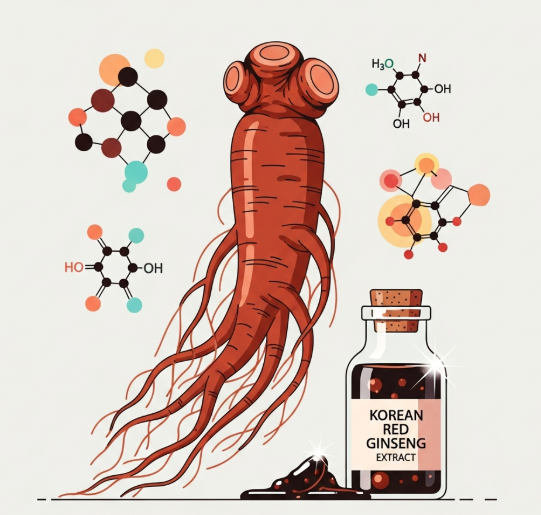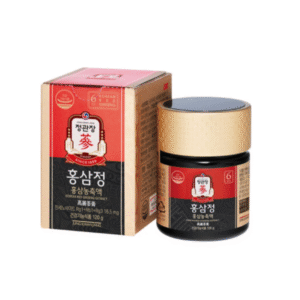1. Introduction: Why Non-Saponins Matter
Most research on Korean Red Ginseng (Panax ginseng) has focused on ginsenosides, the well-known saponin compounds. However, Korean Red Ginseng also contains bioactive non-saponin compounds, increasingly recognized for their health potential. These include phenolic compounds and maltol derivatives, formed during the steaming and drying process through Maillard reactions.
Recent studies have identified maltol derivatives in the water-soluble fraction (WS) of red ginseng, demonstrating significant antioxidant and anti-inflammatory activity. Exploring these non-saponin compounds opens new perspectives on ginseng’s potential — not just as an “energy tonic,” but as a source of molecules supporting oxidative balance and inflammation regulation.
2. What Are Maltol and Maltol Derivatives in Ginseng
- Maltol (3-hydroxy-2-methyl-4-pyrone) is a furanone compound generated during processing (steam + heat).
- Recent research (Journal of Ginseng Research) isolated four major compounds from the WS fraction, two of which were maltol-glucopyranosides, previously unidentified.
- These compounds contain a glucose unit (glucopyranose), enhancing solubility and potentially improving distribution in the body.
- Earlier studies from 1984 also noted novel glucosides in red ginseng, which can degrade into maltol, confirming maltol as a natural byproduct of ginseng processing.
3. Antioxidant Activity of Maltol Derivatives
Non-saponin fractions provide important antioxidant effects:
- In vitro studies (Cho et al., 2023) showed that WS fractions rich in maltol derivatives significantly reduced oxidative stress in neuronal cells (PC-12).
- Antioxidant assays (ABTS, DPPH, FRAP) confirmed strong free radical scavenging activity.
- Antioxidant activity is important because oxidative stress is a driver of cellular aging, chronic inflammation, and functional decline.
4. Anti-Inflammatory Effects: From Cells to Signaling
Maltol derivatives also exhibit anti-inflammatory properties:
- In macrophages (RAW 264.7), WS fraction compounds significantly reduced nitric oxide (NO) and pro-inflammatory cytokines IL-1β, IL-6, TNF-α.
- In keratinocytes (HaCaT), maltol suppressed inflammasome activation (e.g., NLRP3) induced by Staphylococcus aureus, decreasing mitochondrial ROS and IL-1β.
- Maltol can modulate the “priming step” of inflammasome activation, preparing immune cells for response without triggering excessive inflammation.
5. Molecular Implications & Pathways
- Absorption: Maltol-glucose derivatives may be better absorbed due to increased water solubility.
- Metabolic effects: While ginsenosides influence AMPK pathways, maltol may indirectly support metabolic health by reducing oxidative load.
- Inflammasome modulation: Maltol suppresses inflammasome priming, helping regulate inflammation without impairing immune defense.
- Hepatoprotective effects: In animal models, maltol protects the liver from oxidative damage, reducing TNF-α and IL-1β while enhancing SOD, catalase, and GSH-Px activity.
6. Advantages of Non-Saponins vs. Ginsenosides
| Component | Main Activity | Additional Benefits |
|---|---|---|
| Ginsenosides (saponin) | Adaptogenic, metabolic, neuroprotective | High bioactivity, targeted effects |
| Maltol & Non-Saponin Derivatives | Antioxidant, anti-inflammatory, immune modulation | Water-soluble, synergistic, inflammasome regulation |
Due to their chemical structure, maltol derivatives may have unique pharmacokinetics and tissue distribution not achieved by ginsenosides alone.
7. Practical Applications
- Maltol derivatives show potential for functional foods, supplements, and cosmetics due to antioxidant and anti-inflammatory effects.
- Water-soluble fractions can be optimized for bioavailability and stability in formulations.
- Combining ginsenosides with maltol derivatives could create “next-gen” ginseng products, supporting metabolism, inflammation regulation, and oxidative balance.
8. Safety and Tolerability
- Non-saponin fractions have been tested in vitro and in vivo with no significant toxicity at effective concentrations.
- Maltol is widely used in food and cosmetics, suggesting a good safety profile, though standardized ginseng formulations should be quality-controlled.
9. Challenges and Future Research
- In vivo bioavailability: Most studies are in vitro. Human pharmacokinetics are needed.
- Synergy with ginsenosides: Research is required to determine optimal combined effects.
- Clinical models: Studies on chronic inflammation, metabolic stress, or immune modulation are limited.
- Supplement formulation: Stability and activity in tablets, capsules, or liquid forms need optimization.
10. Conclusion
- Korean Red Ginseng contains non-saponin compounds like maltol derivatives with strong antioxidant and anti-inflammatory effects.
- These compounds can regulate inflammasome activity, reduce ROS, and modulate cytokine production.
- Their water solubility and unique bioactivity make them valuable for functional foods, supplements, and cosmetic applications.
- Combining maltol derivatives with ginsenosides may provide synergistic benefits for metabolism, inflammation, and oxidative stress.
- Further research on bioavailability, formulation, and clinical effects will help fully unlock their potential.







